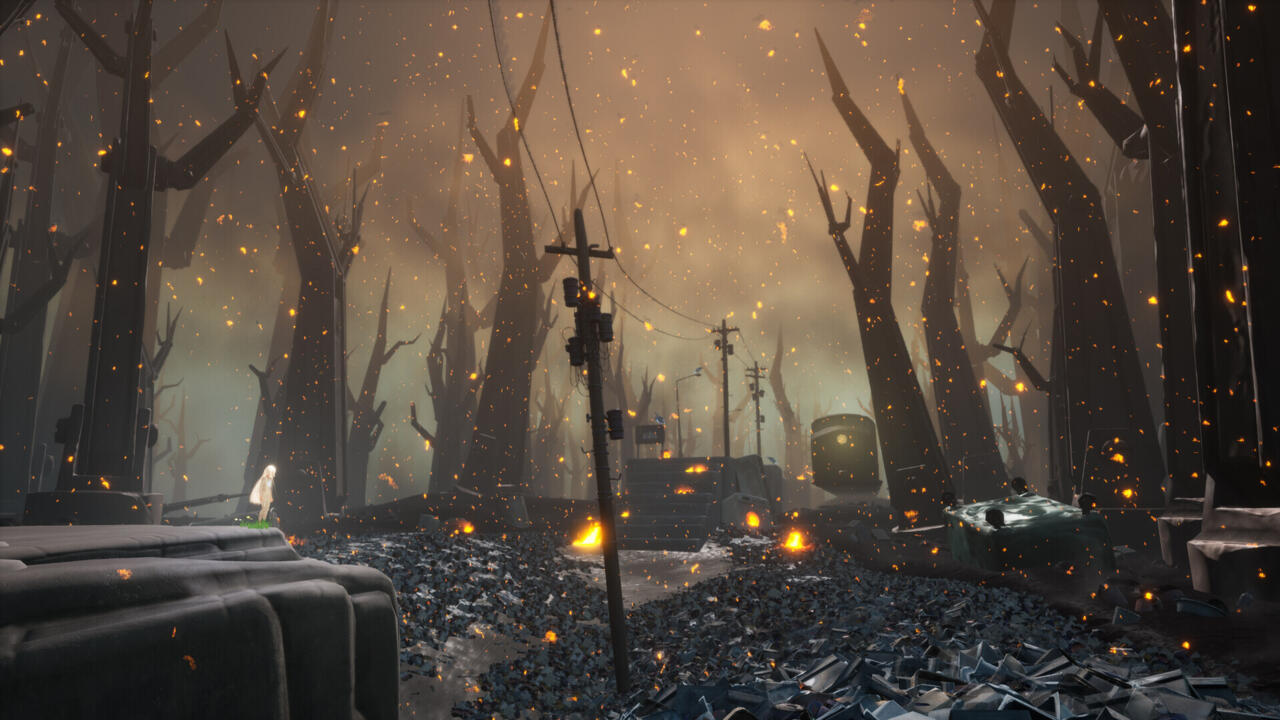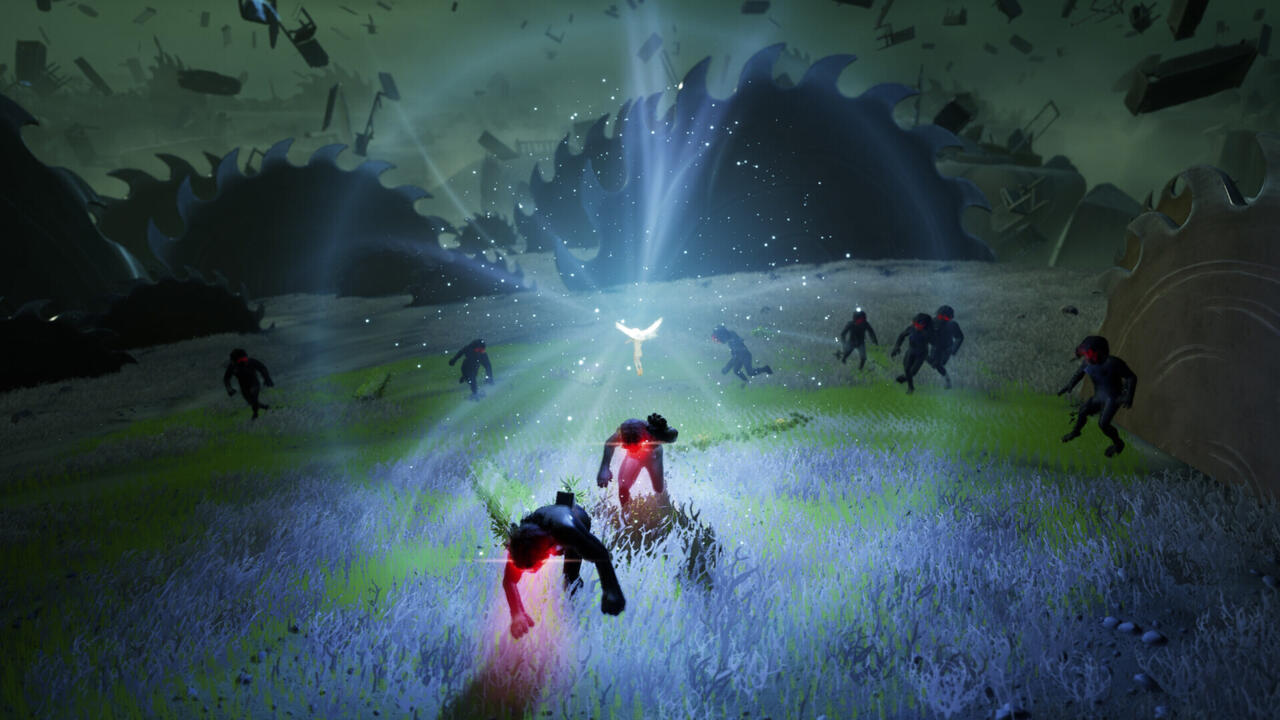Nothing quite compels you to buy into a game's stakes like happening upon the decaying carcass of a dog who's starved to death. This is the first of several emotional moments in After Us. The surrealistic set dressing of this 3D platformer is regularly morbid but it makes for quite a compelling dystopian world to explore, if only to satiate an innate curiosity--how did the Earth end up like this and is there anyone left? The simple combat and good-but-not-great platforming mechanics bog down the experience a bit but After Us' incredible environmental storytelling of a doomed world clinging to a feeble hope more than makes up for it.
In After Us, you play as Gaia, a young spirit tasked with tracking down and salvaging the souls of the last creatures on Earth. These include animals like the aforementioned canine, the last dog who died of hunger, and coming across others lead to plenty of somber moments of human cruelty--the last eagle caged and plucked, for instance, and the final whale to be harpooned. There's a present-day storyline that runs parallel that isn't all that interesting as it's difficult to relate to the mostly-silent Gaia, who displays small signs of emotion during certain cutscenes but seems to largely view the world around her with passivity. The history of this Earth's past, which you uncover in your pursuit of the lost animal souls and optional collectibles, is far more captivating and works as a strong narrative backbone for the platformer.

Running and jumping are Gaia's primary ways of navigating the world, and these actions are complemented by other platforming staples like hovering, rail-grinding, wall-running, and dashing. She's a bit too floaty and loose to control in certain platforming segments--there were quite a few moments where a frustrating mistiming meant I accidentally leaped over a floating chunk of freeway and plunged to my death or sprinted a step too far and skidded off the top of a skyscraper. Most often, failure was the result of the controls working against me, not my own mistakes. Thankfully, the checkpoint system in After Us is relatively forgiving so even the most irritating of deaths are only small setbacks.
The platforming mechanics excel in more momentum-driven instances, like running up the sides of dilapidated steel structures to reach the top of a signal tower that's slowly falling apart or leaping between power lines as lightning crackles around you and briefing illuminates the next jump you need to make. The momentum of Gaia's movements makes things tricky when the game asks you to take things slow and focus on precision, but the exciting sense of speed she can achieve makes for some fun highlights during the game's more action-focused moments.
After Us occasionally dips its toes into combat and puzzles too, the latter of which I enjoyed more than the former. Combat is quite simple and not very engaging. As Gaia races through the world, she'll run into the final remnants of mankind, the oil-coated Devourers. They lumber after Gaia, lunging at her with easily dodgeable grapples. If they do happen to nab her, escaping the grab is a simple quick-time event. They don't pose much of a threat to the nimble Gaia, who can put them to rest with ease by blasting them with a ball of pure life energy. Combat does get a bit trickier when shielded enemies show up--in a fun twist, they use television screens to block out your weapon, life, to protect their oil-dependent lives. In these fights, you have to time Gaia's attacks instead of just blasting indiscriminately. But these enemies soon become easy to overcome as well, especially with regular use of Gaia's quick-to-charge, area-of-effect stun. Battles against Devourers are just too simple and samey to be enjoyable.

The puzzles, on the other hand, are a delight. For the most part, they aren't overly complicated, avoiding the trap of falling into tedium. Pretty much every puzzle is built around the platforming but what you're being tasked to do changes to reflect the various environments, creating a nice diversity of challenges. One moment, you have to figure out how to reach junction boxes to power on a TV, then flip between channels until you find the one that will teleport you to the next platform you have to reach. The next, you're slowly ascending through a series of bird cages that open and close whenever Gaia uses her area-of-effect stun on them, forcing you to carefully time the momentum of your running and jumping with the speed of your attacks. After Us regularly builds on its puzzles within the same level too, sometimes several times, creating complexity and challenge by requiring increasingly difficult execution. I may know that I need to plug in the television and change it to the airplane channel to progress--it's a variation of a problem I'd already solved earlier--but now I have to figure out how to reach three junction boxes to power the TV on, not just one. It's the same problem, so I understand what I need to do at the jump, but now it's just a bit harder.
This style of puzzle progression allows After Us to maintain the forward momentum of its story. You're rarely wracking your brain over where you need to go or what exactly you need to do for very long. And even if you do run into a roadblock with a puzzle, After Us is rather open-ended following its very linear opening. Soon into the game, the path forward branches, giving you a choice over where you want to go next. A fast travel system makes it easy to return to these branches whenever you want, meaning you can take a break from the path you're on at any given moment if it's giving you trouble and return to it later. This also eases the pressure for completionists as you can go back to grab collectibles you missed--which are graciously marked on your map regardless if you actually saw them when you passed them by--at any point.
The star of the show, however, is the visuals. The abstract nature of the spaces that Gaia explores depicts the impact of humanity on nature in this horrific yet oddly beautiful way. Polluted skies crackle with fierce lightning, illuminating crumbling buildings and pools of sentient oil that greedily reach for Gaia with hungry tendrils as she passes, desperate to consume the last remnants of meager light in an increasingly dark world. A dark room is littered with angelic feathers, dozens of empty cages strung up above hinting at the desperate last days of the birds that once filled the skies--skies that now cloud your vision with viscous smoke. Most eerie of all are the lifeless statues that populate every level of the game, as if all of humanity was simultaneously petrified at the dawn of the end of the world.

Optional collectibles slowly reveal how the world came to be this way but it isn't hard to discern if you pay attention. The dry oceans, razed forests, and trash-choked cities all speak to a civilization that continued to take and take without any care for future generations. After Us' visual storytelling doesn't wholly condemn humanity, however, using brief snippets of love and hope among the rubble of civilization to add a dash of tragedy to the decimation. There's a bewitching sadness to the whole thing, with the abstract world feeling reminiscent of experiences like Little Nightmares and Inside.
You can find statues of running children, frozen mere inches away from their parents' outstretched arms, just short of being reunited as the world came to a close. You can find the petrified remains of people gathering together in an illuminated square of brilliant light and just holding one another, choosing hope even as the world burned down around them. For as much as After Us initially decries humanity and labels them as Devourers, the agents of consumption and greed, the game ultimately posits that they are victims of their own hubris, with too many who confused the pursuit of progress for happiness.
The surreal world design of After Us' dystopian world carries the game, encouraging you to keep going even when the momentum-driven platforming and creative puzzles give way to tedious combat. Gaia isn't all that compelling a protagonist, but the stories she uncovers--whether they're of the Earth's final animals or the Devourers who killed them--make up for it, inviting you to delve deeper into the dark of After Us' dying world and uncover exactly how it all fell apart.